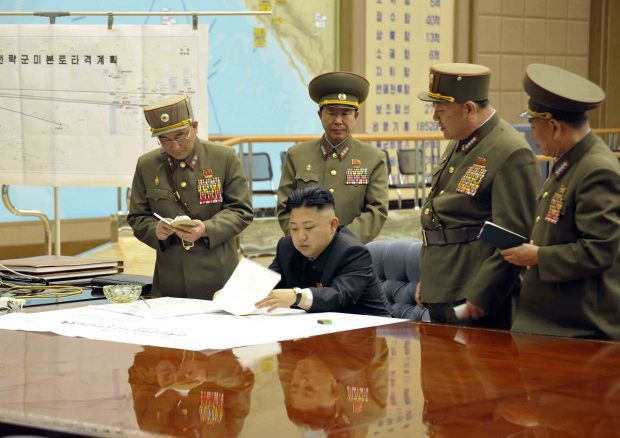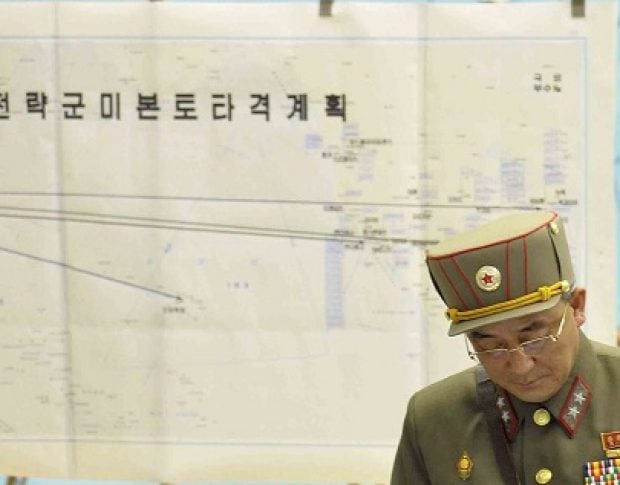Where Might Kim Jong Un Strike If He Gets His Treasured ICBM?
by Ryan Pickrell, Daily Caller, May 19, 2017
North Korea is squaring off with a superpower, and propaganda has offered insight into the targets the North might aim for in the event of a conflict.
North Korea’s missile and nuclear weapons technology is advancing rapidly. The North successfully tested a Hwasong-12 intermediate-range ballistic missile Sunday that some observers suspect may be the foundation for a future intercontinental ballistic missile (ICBM), the key to threatening the U.S. mainland.
“The objective is to preserve the regime, right?” Vipin Narang, a MIT professor with a deep knowledge of nuclear strategy, told The Washington Post. “You really have to stop the invasion. If you think you need nuclear weapons to do that, how do you deal with the fact that the U.S. is going to make you a smoldering, radioactive hole at the end of that? Well, if you can hold American homeland targets at risk, that might induce caution.”
The North is still developing the technology to strike the U.S. with an ICBM, despite their aggressive threats. Nonetheless, North Korean propaganda offers insight into the targets they might shoot for if they had one.
A North Korean photo from 2013 reveals a map, which some analysts call the “Map of Death,” identifying U.S. targets for potential nuclear strikes.

North Korean leader Kim Jong-un presides over an urgent operation meeting on the Korean People’s Army Strategic Rocket Force’s performance of duty for firepower strike at the Supreme Command in Pyongyang. The sign on the left reads, “Strategic force’s plan to hit the mainland of the U.S.”. REUTERS/KCNA
Open source intelligence analysts suspect that the four targets identified on the map are Hawaii, San Diego, Barksdale Air Force Base in Louisiana, and Washington, D.C. The U.S. Navy’s Pacific fleet is headquartered in Hawaii, and its home base is in San Diego. Barksdale is the headquarters for Air Force Global Strike Command, which is essential for U.S. nuclear deterrence and global strikes. The Department of Defense and other national security agencies are located in D.C.

Amplified image of the map from the meeting (Reuters via KCNA)
Other analysts add Offutt Air Force Base in Nebraska, where U.S. Strategic Command is located, and Whiteman Air Force Base in Missouri, home to nuclear-capable B-2 stealth bombers, according to WaPo. The North could also potentially threaten Seattle or San Francisco. North Korea revealed a propaganda video featuring a simulated nuclear strike on the latter during a state concert celebrating the 105th anniversary of the birth of North Korean founder Kim Il Sung last month.
An ICBM test is expected this year, according to Director of National Intelligence Dan Coats.
While it cannot yet strike the U.S. mainland, North Korea has the weapons technology to hold Northeast Asia hostage.
Eager to stave off a U.S. invasion, the North, according to the rhetoric in their state media reports, would likely focus on U.S. military bases and high-profile strategic assets, like the Terminal High Altitude Area Defense anti-missile system being installed in South Korea.
North Korea launched a salvo of extended-range Scud missiles early March into the East Sea/Sea of Japan, with North Korean state media claiming the Korean People’s Army was rehearsing for strikes on U.S. bases in Japan. Open source intelligence reports revealed the North was aiming for Iwakuni Marine Corps Air Station, where a squadron of forward-deployed F-35s were stationed. When the USS Ohio made a port call to Busan last year, the North fired a missile into the sea. Open source intelligence, coupled with media reports at the time, revealed that the North was practicing bombing Busan.
The North’s newest missile, the Hwasong-12, has a range that puts Guam, specifically Anderson Air Force Base, within striking distance. The U.S. has a number of strategic bombers stationed in Guam, several of which have flown past the DMZ in a show of force.
“If the US goes reckless, misjudging the trend of the times and the strategic position of the [Democratic People’s Republic of Korea], all the US military bases in the operational theater in the Pacific, including Guam, will face ruin in the face of an all-out and substantial attack mounted by the army of the DPRK,” a North Korean Foreign Ministry spokesperson told the Korean Central News Agency (KCNA) in August last year.